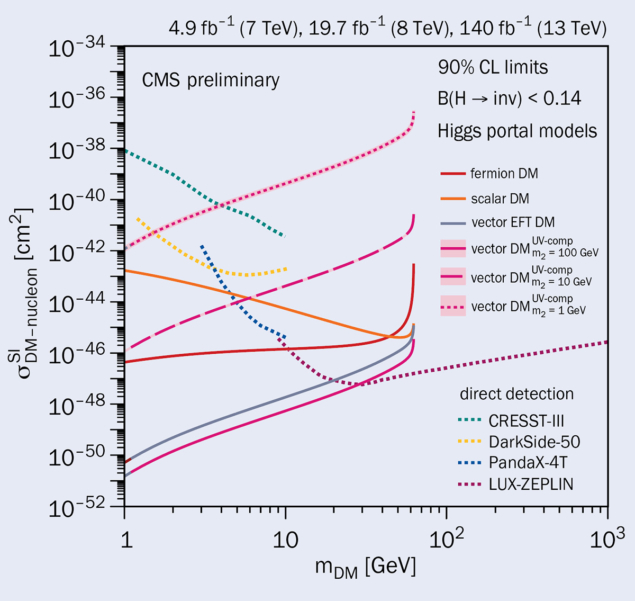A report from the CMS experiment.

In the Standard Model (SM) of particle physics, the only way the Higgs boson can decay without leaving any traces in the LHC detectors is through the four-neutrino decay, H → ZZ → 4ν, which has an expected branching fraction of only 0.1%. This very small value can be seen as a difficulty but is also an exciting opportunity. Indeed, several theories of physics beyond the SM predict considerably enhanced values for the branching fraction of invisible Higgs-boson decays. In one of the most interesting scenarios, the Higgs boson acts as a portal to the dark sector by decaying to a pair of dark matter (DM) particles. Measurements of the “Higgs to invisible” branching fraction are clearly among the most important tools available to the LHC experiments in their searches for direct evidence of DM particles.
The CMS collaboration recently reported the combined results of different searches for invisible Higgs-boson decays, using data collected at 7, 8 and 13 TeV centre-of-mass energies. To find such a rare signal among the overwhelming background produced by SM processes, the study considers events in most Higgs-boson production modes: via vector boson (W or Z) fusion, via gluon fusion and in association with a top quark–antiquark pair or a vector boson. In particular, the analysis looked at hadronically decaying vector bosons or top quark–antiquark pairs. A typical signature for invisible Higgs-boson decays is a large missing energy in the detector, so that the missing transverse energy plays a crucial role in the analysis. No significant signal has been seen, so a new and stricter upper limit is set on the probability that the Higgs boson decays to invisible particles: 15% at 95% confidence level.
This result has been interpreted in the context of Higgs-portal models, which introduce a dark Higgs sector and consider several dark Higgs-boson masses. The extracted upper limits on the spin-independent DM-nucleon scattering cross section, shown in figure 1 for a range of DM mass points, have better sensitivities than those of direct searches over the 1–100 GeV range of DM masses. Once the Run 3 data will be added to the analysis, much stricter limits will be reached or, if we are lucky, evidence for DM production at the LHC will be seen.
Further reading
CMS Collab. 2022 CMS-PAS-HIG-21-007.








